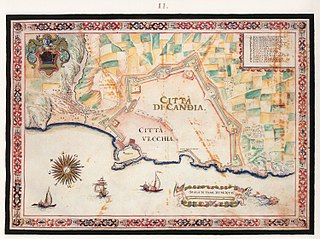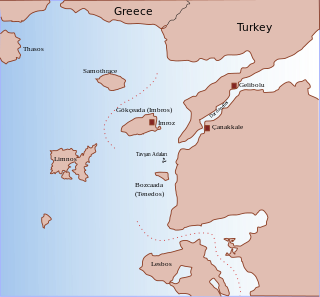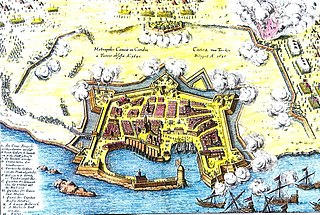
The Battle of Focchies was a significant naval engagement that took place on 12 May 1649, in the harbour of Focchies, Smyrna between a Venetian force of nineteen warships under the command of Giacomo da Riva, and an Ottoman force of eleven warships, ten galleasses, and seventy-two galleys, with the battle resulting in a crushing victory for the Venetian fleet. The battle was an episode in the Cretan War from 1645 to 1669 between the Venetian Republic and the Ottoman Empire over dominance of various territories in the Mediterranean Sea. The war was one in a series of wars between the two warring powers, which contested for control of the Adriatic and Mediterranean trade routes. The primary territory that was contested during the war was Crete, the largest and most profitable of the overseas holdings of the Venetian Republic. The battle came after a squadron of Venetian ships under the command of Giacomo da Riva, a Venetian admiral, came to the rescue of the blockading Venetian force in the Dardanelles Straits, after the blockade had run into unexpected weather conditions and many ships sunk as a result.
This battle took place on 26 May 1646 at the mouth of the Dardanelles Strait, during the Cretan War. The Ottoman fleet under the Kapudan Pasha, Kara Musa Pasha, tried to defeat the Venetian fleet, under Tommaso Morosini. The Venetians were blockading the Dardanelles, trying thus to prevent reinforcements and supplies to be brought to Crete, a Venetian possessions which the Ottomans had invaded the previous year, and to disrupt the flow of supplies to the Ottoman capital, Constantinople.
This battle took place on 21 June 1655 inside the mouth of the Dardanelles Strait. It was a clear victory for Venice over the Ottoman Empire during the Cretan War.

The Third Battle of the Dardanelles in the Fifth Ottoman-Venetian War took place on 26 and 27 June 1656 inside the Dardanelles Strait. The battle was a clear victory for Venice and the Knights Hospitaller over the Ottoman Empire, although their commander, Lorenzo Marcello, was killed on the first day.

The Fourth Battle of the Dardanelles in the Fifth Ottoman-Venetian War took place between 17 and 19 July 1657 outside the mouth of the Dardanelles Strait. The Ottomans succeeded in breaking the Venetian blockade over the Straits.
The Battle of Andros took place on 22 August 1696 southeast of the Greek island of Andros between the fleets of the Republic of Venice and the Papal States under Bartolomeo Contarini on the one side and the Ottoman Navy, under Mezzo Morto Hüseyin Pasha, and allied Barbary forces on the other. The encounter was indecisive, and no vessels were lost on either side.
This battle, which took place on 16 May 1654, was the first of a series of tough battles just inside the mouth of the Dardanelles Strait, as Venice and sometimes the other Christian forces attempted to hold the Turks back from their invasion of Crete by attacking them early.
The Battle of the Oinousses Islands comprised two separate actions, on 9 and 19 February 1695 near the Oinousses, a small island group off Cape Karaburun in western Anatolia, between a Venetian fleet under Antonio Zeno and the Ottoman fleet under Mezzo Morto Hüseyin. The result of the first battle was a Venetian defeat, and although the second engagement ended in a draw, the Venetian position in Chios became untenable, forcing Zeno to abandon the island, which had been captured a few months earlier.

The Action of 8 July 1716 was an indecisive naval battle that took place on 8 July 1716 during a Turkish attempt to capture the island of Corfu (Kerkyra), off the west coast of mainland Greece.

The Morean war, also known as the Sixth Ottoman–Venetian War, was fought between 1684–1699 as part of the wider conflict known as the "Great Turkish War", between the Republic of Venice and the Ottoman Empire. Military operations ranged from Dalmatia to the Aegean Sea, but the war's major campaign was the Venetian conquest of the Morea (Peloponnese) peninsula in southern Greece. On the Venetian side, the war was fought to avenge the loss of Crete in the Cretan War (1645–1669). It happened while the Ottomans were entangled in their northern struggle against the Habsburgs – beginning with the failed Ottoman attempt to conquer Vienna and ending with the Habsburgs gaining Buda and the whole of Hungary, leaving the Ottoman Empire unable to concentrate its forces against the Venetians. As such, the Morean War was the only Ottoman–Venetian conflict from which Venice emerged victorious, gaining significant territory. Venice's expansionist revival would be short-lived, as its gains would be reversed by the Ottomans in 1718.

The Cretan War, also known as the War of Candia or the Fifth Ottoman–Venetian War, was a conflict between the Republic of Venice and her allies against the Ottoman Empire and the Barbary States, because it was largely fought over the island of Crete, Venice's largest and richest overseas possession. The war lasted from 1645 to 1669 and was fought in Crete, especially in the city of Candia, and in numerous naval engagements and raids around the Aegean Sea, with Dalmatia providing a secondary theater of operations.

Lorenzo Marcello was a Venetian admiral.

The siege of Corfu took place on 8 July – 21 August 1716, when the Ottoman Empire besieged the city of Corfu, on the namesake island, then held by the Republic of Venice. The siege was part of the Seventh Ottoman–Venetian War, and, coming in the aftermath of the lightning conquest of the Morea by the Ottoman forces in the previous year, was a major success for Venice, representing its last major military success and allowing it to preserve its rule over the Ionian Islands.

The Battle of Gallipoli occurred on 29 May 1416 between the fleets of the Republic of Venice and the Ottoman Empire off the port city of Gallipoli, the main Ottoman naval base. The battle was the main episode of a brief conflict between the two powers, resulting from Ottoman attacks against possessions and shipping of the Venetians and their allies in the Aegean Sea in 1414–1415. The Venetian fleet, under Pietro Loredan, was charged with transporting a Venetian embassy to the Ottoman sultan, but was authorized to attack if the Ottomans refused to negotiate. The subsequent events are known chiefly from a detailed letter written by Loredan after the battle.

Lazzaro Mocenigo was a Venetian nobleman who distinguished himself as an admiral during the Cretan War against the Ottoman Empire.

The Battle of Kalamata took place on 14 September 1685 between the expeditionary army of the Republic of Venice in the Morea, led by Hannibal von Degenfeld, and the forces of the Ottoman Empire, led by the Kapudan Pasha. The battle ended in a Venetian victory, which allowed the Venetians to complete the conquest of the Mani Peninsula, solidifying their foothold in the southern Morea.

The Siege of Chania happened during the initial stages of Cretan War (1645–1669). The Ottomans besieged the Venetian-held city of Chania, and after 56 days of siege, the Ottomans captured the city.

The Siege of Chania in 1660 was an attempt by the Christian forces to recapture the city from the Ottoman hold. The Ottoman managed to thwart the Christian attempt to capture the city.

The Siege of Rethymno happened during the Cretan War when the Ottomans launched a campaign to conquer the city of Rethymno in Crete from the Venetians. The Ottomans captured the city in the end.
The Battle of Chania took place on 14 August 1646, when the fleet of the Republic of Venice and her allies, under Giovanni Cappello, tried to destroy the Ottoman ships at anchor in the port of Chania, on Crete. The attack was a failure, as the Venetians could not penetrate the harbour defences.














